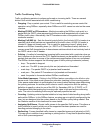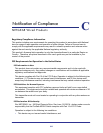
Configuration Examples
518
ProSafe M5300 Switch
All UDP packet flows destined to the 192.12.2.0 network with an IP source address from the
192.12.1.0 network that have a Layer 4 Source port of 4567 and Destination port of 4568
from this switch on ports 7 and 8 are assigned to hardware queue 3.
On this network, traffic from streaming applications uses UDP port 4567 as the source and
4568 as the destination. This real-time traffic is time sensitive, so it is assigned to a
high-priority hardware queue. By default, data traffic uses hardware queue 0, which is
designated as a best-effort queue.
Also the confirmed action on this flow is to send the packets with a committed rate of
1000000
Kbps and burst size of 128 KB. Packets that violate the committed rate and burst
size are dropped.
802.1X
Local Area Networks (LANs) are often deployed in environments that permit unauthorized
devices to be physically attached to the LAN infrastructure, or permit unauthorized users to
attempt to access the LAN through equipment already attached. In such environments, it may
be desirable to restrict access to the services offered by the LAN to those users and devices
that are permitted to use those services.
Port-based network access control makes use of the physical characteristics of LAN
infrastructures in order to provide a means of authenticating and authorizing devices attached
to a LAN port that has point-to-point connection characteristics and of preventing access to
that port in cases in which the authentication and authorization process fails. In this context, a
port is a single point of attachment to the LAN, such as ports of MAC bridges and
associations between stations or access points in IEEE 802.11 Wireless LANs.
The IEEE 802.11 standard describes an architectural framework within which authentication
and consequent actions take place. It also establishes the requirements for a protocol
between the authenticator (the system that passes an authentication request to the
authentication server) and the supplicant (the system that requests authentication), as well as
between the authenticator and the authentication server.
The managed switch switches support a guest VLAN, which allows unauthenticated users to
have limited access to the network resources.
Note: You can use QoS features to provide rate limiting on the guest VLAN
to limit the network resources the guest VLAN provides.
Another 802.1X feature is the ability to configure a port to Enable/Disable EAPoL packet
forwarding support. You can disable or enable the forwarding of EAPoL when 802.1X is
disabled on the device.
The ports of an 802.1X authenticator switch provide the means in which it can offer services
to other systems reachable via the LAN. Port-based network access control allows the


















